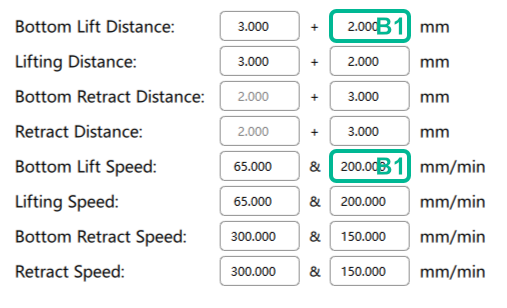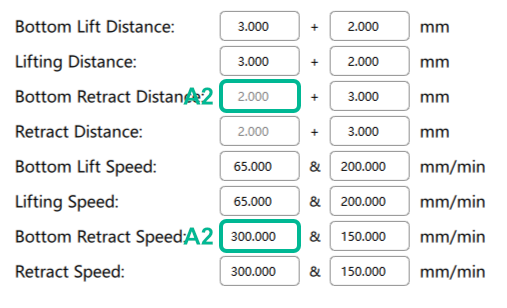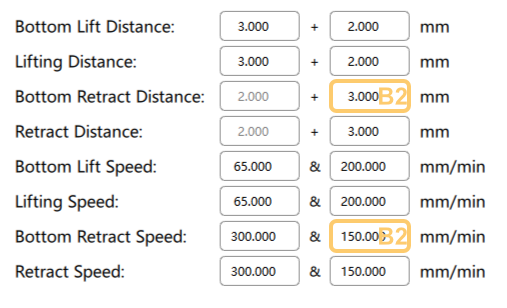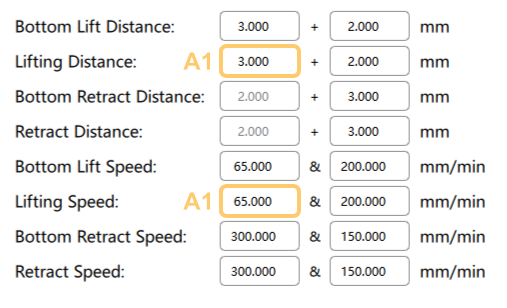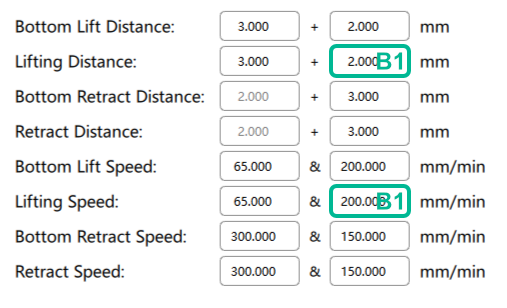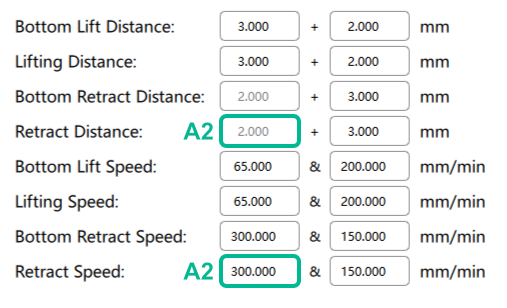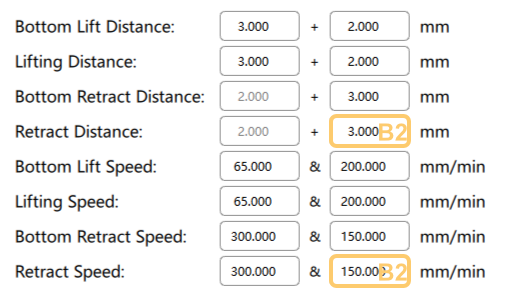Configure Print Parameters
Add a printer before configure your print parameters. See here on how to add a printer.
One printer can store multiple slicing configuration profiles. You can manage your profiles in the Slicing Profile Panel, where you can add, delete, import, export, and reset your profiles.
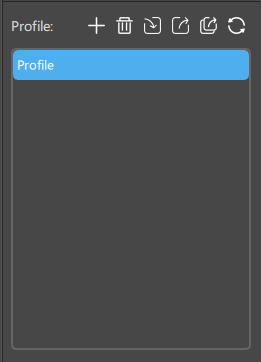
Double click a profile to open the slice profile configuration window.
Slice Configuration
Resin
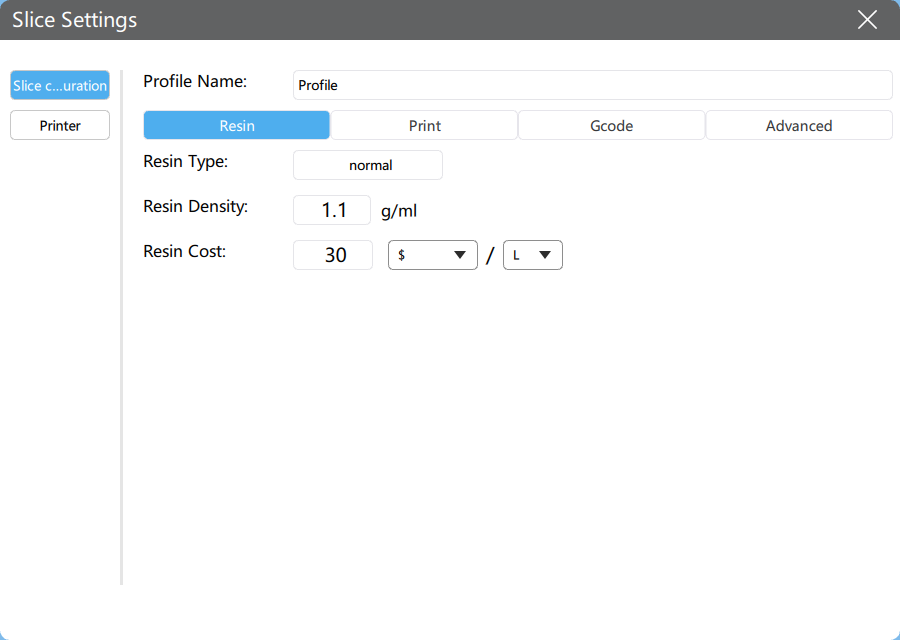
Set your resin type, density, and cost here.
Print
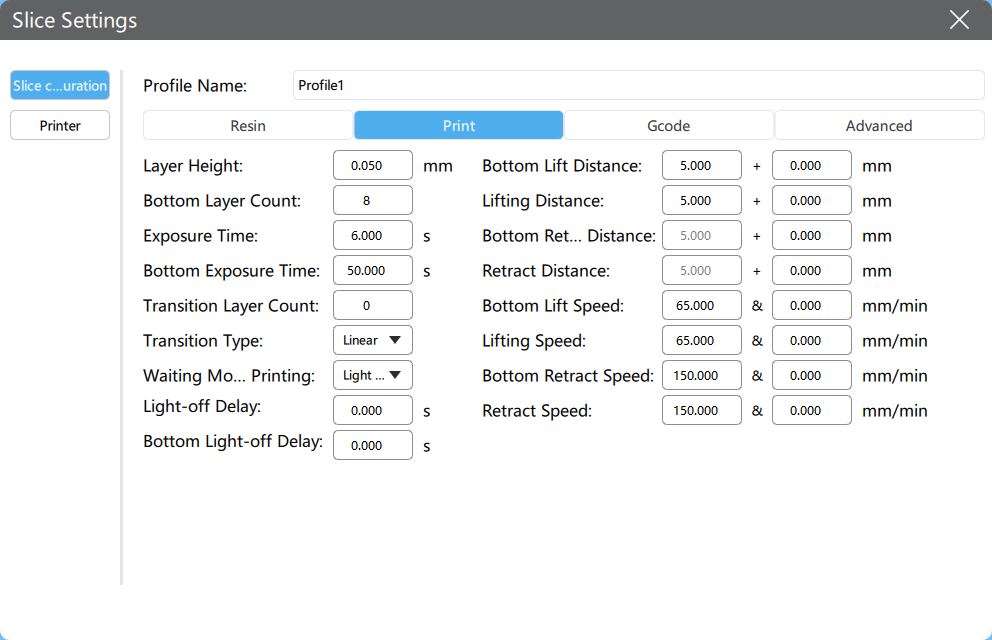
Set your print parameters here.
Not all printers support Resting Time waiting mode. Read the 📃full compatibility list here.
1 TSMC
Not all printers support TSMC. Read the 📃full compatibility list here.
In order to shorten the printing time and ensure a higher printing success rate, CHITUBOX divides the original constant speed into two speed segments, a.k.a TSMC (Two-Stage Motion Control). When the printing platform is moving away from the printing face, it is allowed to move at a faster speed.
Traditionally, there are only 2 sub-stages for a single motion cycle. With TSMC was introduced, we now have 4 sub-stages for a single motion cycle:
With the difference between normal layers and bottom layers, there are 8 pairs of parameters, as highlighted in the table below:
Data in the table is for demonstration purposes only. Please adjust the settings as per your needs.
Please note that each Distance has its corresponding Speed. For example,
Bottom Lift Distance corresponds to Bottom Lift Speed, The speed for
a non-zero Distance with cannot be 0, vice versa.
If you hope to stay in Legacy Motion Control, you can keep the second column all-zero, which will remove B1 and B2.
You may find that the motion control doesn't work as per the parameter you set sometimes. This be caused by the limitation of the maximum speed in the printer's factory preset. Please contact the printer's manufacturer for details.
2 Waiting Mode During Printing
2.1 Resting Time
In order to simplify the calculation of Light Off Delay, CHITUBOX launched a new Waiting Mode During Printing, Resting Time, with which you simply need to fill in Rest Time Before Lift, Rest Time After Lift, Rest Time After Retract without tedious calculations.
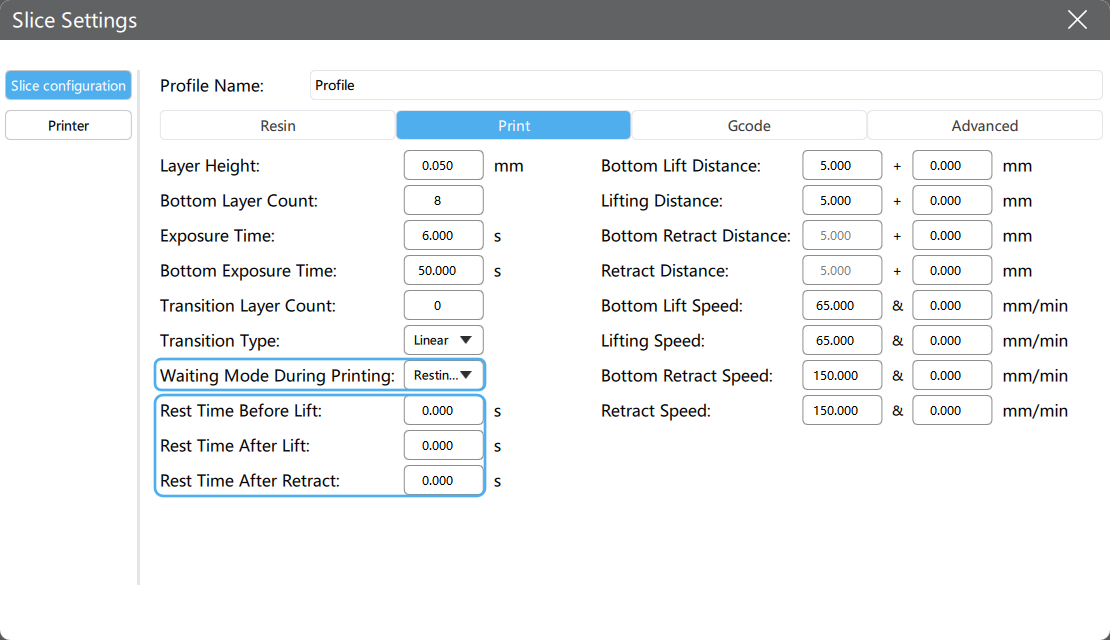
2.2 Light Off Delay
2.2.1 What is Light-off Delay?
Light-off delay is the total time of build plate lifts up, wait, and retract during resin 3D printing of one layer.
It's vital to leave the resin sufficient time to be stabilized before the printer starts printing the next layer. Usually the longer time you set for the light-off delay, the better, sharper, and higher-resolution printing results you got. However setting a prolonged light-off delay also means the entire print process would be unnecessarily long.
The time for lift up and retract depends on the distance of lift up, while wait does not have dependencies. We recommended a 2~3 seconds wait for general print purposes.
2.2.2 Light-off Delay Calculation in CHITUBOX
To calculate the light-off delay, you will need to know lifting distance, lifting speed, and retract speed first. Adding additional 2~3 seconds of wait time to the total time for lifting and retracting gives you the light-off delay.
Light-off delay = Time for lifting + Time for retracting + Wait time
Here is an example:
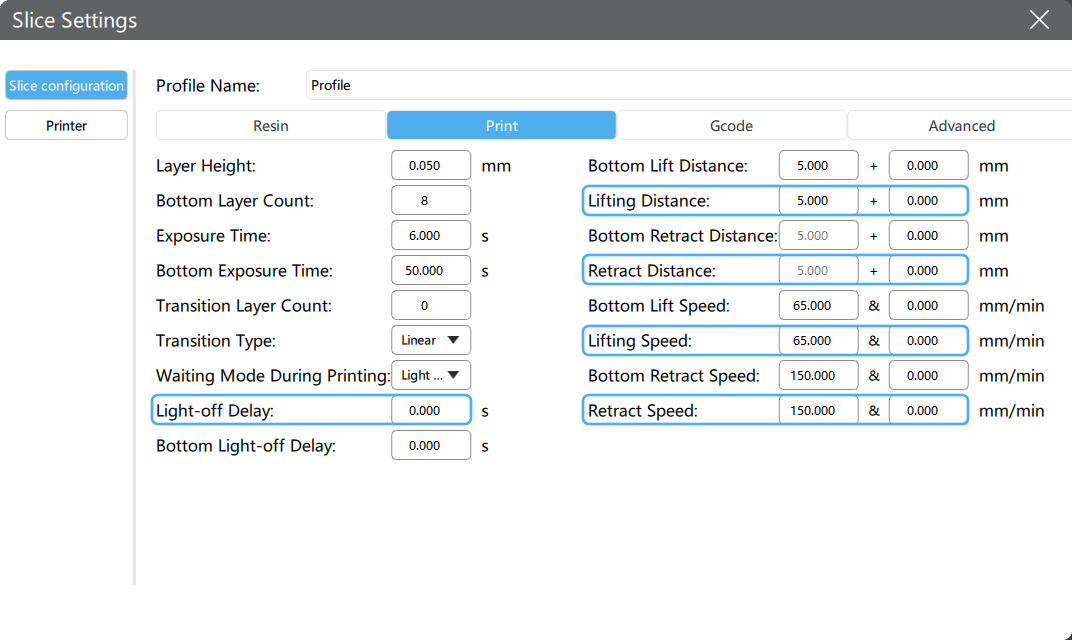
Here the Lifting Distance is 7mm, Lifting Speed is 70mm/min (1.167mm/sec), So the lifting time is:
Similarly, the Retract Speed is 210mm/min (3.5mm/sec), the retracting time is:
If we want a minimum wait time longer than 2s, the light-off delay should:
Inputing a number less than for Light-off Delay will not work.
2.2.3 Light-off Delay Calculator
Modify editable fields to get Light-off Delay.
Buffer
Gcode
Don't edit anything here if you don't know what you're doing.
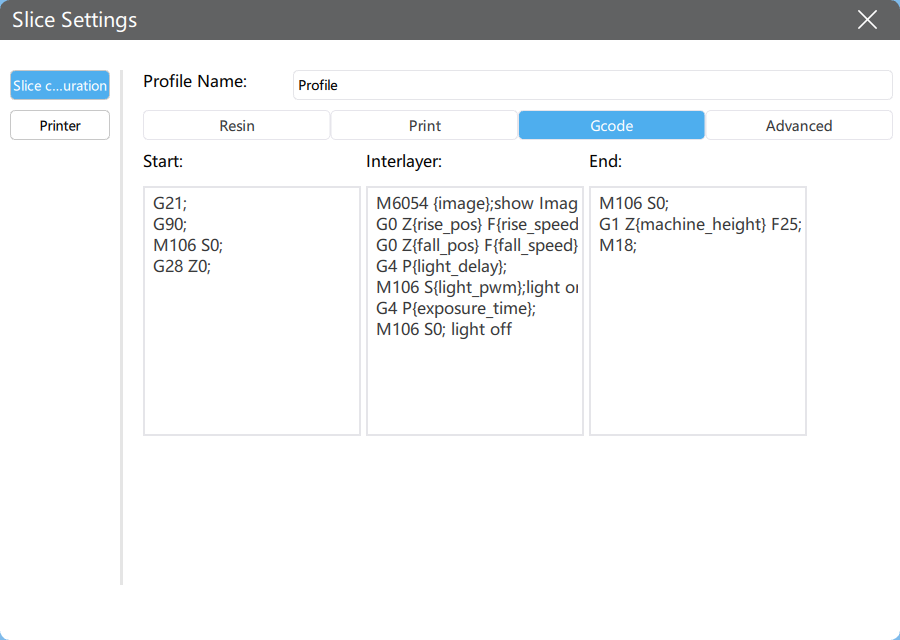
Only .zip and its derived formats (ex. .cws) support Gcode editing.
Advanced Settings
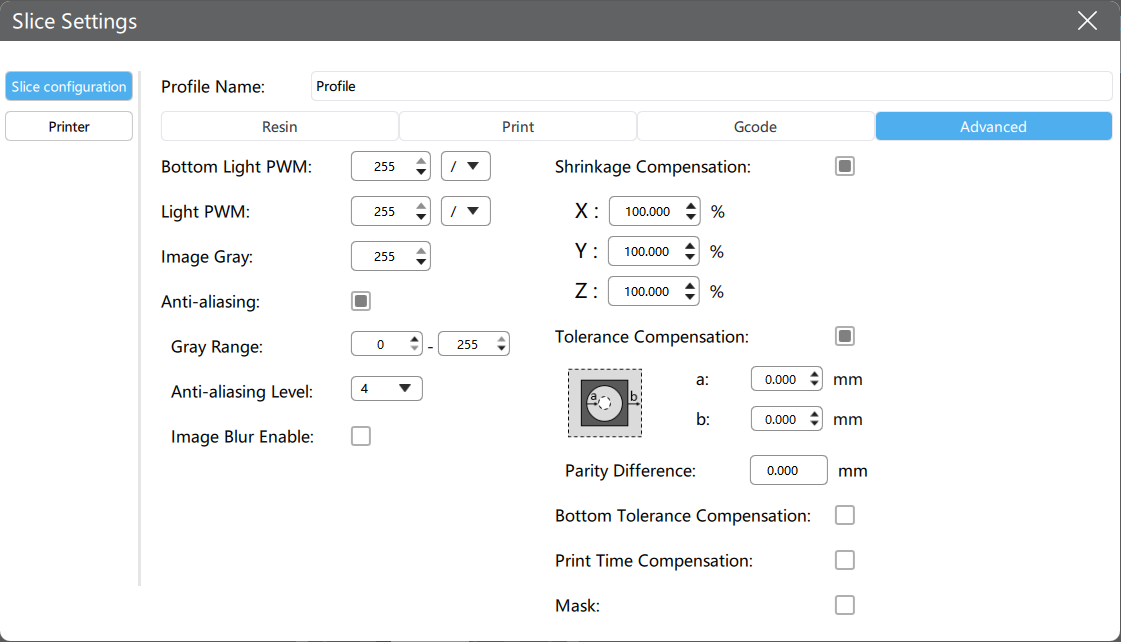
1. Bottom Light PWM
Light PWM for bottom layers, from 0 to 255 , controls the power of the UV light source for bottom layers.
Click here to learn more information about PWM.
2. Light PWM
Light PWM for normal layers, from 0 to 255 , controls the power of the UV light source.
3. Image Gray
Image gray levels, similar to Light PWM, controls the light transmittance of the LCD screen instead of controlling the power of the UV light source.
4. Anti-aliasing
Anti-aliasting softens the triangular sawtooth of image edge to achieve smoother surface effect. The continuity of edge exposure and the intensity of light transmission can be adjusted by adding or deleting pixel units with certain gray levels between adjacent triangular serrations to achieve smoother edge areas.
-
Gray Range :
0~255,0stands for black,255stands for white, designed for .ctb format. It determines the gray range that is available for anti-aliasing.The conversion formula for converting Grey Level in CHITUBOX Basic (
0to8) to Grey Range(0to255) is:The first parameter of Grey Range = (n = 1, 2 , 3, …, 8)
The second parameter of Grey Range is
255. When n = 0, the first parameter of Grey Range is0.For example, if you set the gray level in the Basic version to 2 (when the level is n = 2), and you want to achieve the same effect in the Pro version, then the gray range of the corresponding first parameter is:
-
Anti-aliasing Level :
2,4,8, designed for .cbddlp format. It determines the edge exposure time. The higher the level you select, the longer the exposure time will be, this will result in sharper edges, thereby decreasing the effect of anti-aliasing. -
Image Blur Enable : Enable/Disable image blur, designed for .ctb format.
-
Image Blur Pixel :
2~8, determines the number of pixels for edge transition, the higher level you select, the softer edge would be. Similar to the feather function in Photoshop.
-
Open 📺this video and 📃this article to learn more about Anti-aliasing, Grayscale, and Image Blur.
5. Shrinkage Compensation
Shrinkage compensation of the model in X, Y, and Z directions. The percentage represents the size compared to the original size. The default value is 100%.
The model body is larger with a larger percentage value.
The model body is smaller with a smaller percentage value.
6. Tolerance Compensation
Inner and outer diameter compensation of normal printing layers
When a is larger, the inner diameter is shorter, and the model body is larger.
When a is smaller, the inner diameter is longer, and the model body is smaller.
When b is larger, the outer diameter is longer, and the model body is larger. When b is smaller, the outer diameter is shorter, and the model body is smaller.
Parity Compensation : Shrink designated value, effect on even layers only. This will expand the layer if a negative value was specified.
Open 📺this video and 📃this article to learn more about Tolerance Compensation.
7. Bottom Tolerance Compensation
Inner and outer diameter compensation of bottom printing layers
When a is larger, the inner diameter is shorter, and the model body is larger.
When a is smaller, the inner diameter is longer, and the model body is smaller.
When b is larger, the outer diameter is longer, and the model body is larger.
When b is smaller, the outer diameter is shorter, and the model body is smaller.
When the bottom layer tolerance compensation is disabled, the normal layer tolerance compensation will be effective for the whole model.
8. Print Time Compensation
Some high-resolution printers can have extra delays when loading data and will lead to inaccurate printing time estimation. You can set up a time compensation to improve the issue.
-
Manual Input
Layer Print Time Compensation: a 2-digit number between
-99.99and99.99, with default set at0s.When enabled, the Estimated Time For A Single Layer = Exposure Time + Waiting Time + Movement Time + Layer Print Time Compensation
-
Auto Generation
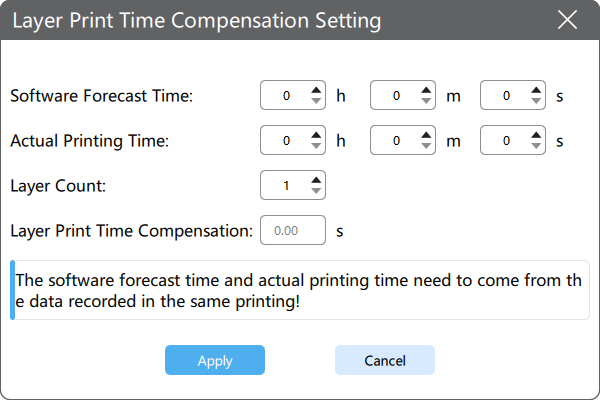
Layer Print Time Compensation =
NOTERemember to click Apply after changing parameters, otherwise, the parameters won't take effect.
9. Mask
Mask is designed to solve a common light source issue of uneven light strength at different spots of the screen. The issue is usually caused by improper light sources. The purpose of the mask is to provide a correction layer on the screen by adjusting the transmittance on different areas of the screen respectively, making the uneven light homogeneous.
Mask File : You can select an existing image by clicking ... icon or create a new one using CHITUBOX's built-in mask generator by clicking the gear icon.
Gray scale unit : click here to learn more about gray scale unit.
9.1 Mask Generator
9.1.1 Hub-and-Spoke
Hub-and-Spoke generate a ripple-like pattern. The number of circles is set by Number of equal parts. Radius of circles are arithmetic sequence with a delta set by Equal radius.
The range of Gray Parameter is from 0 (black) to 255 (white).
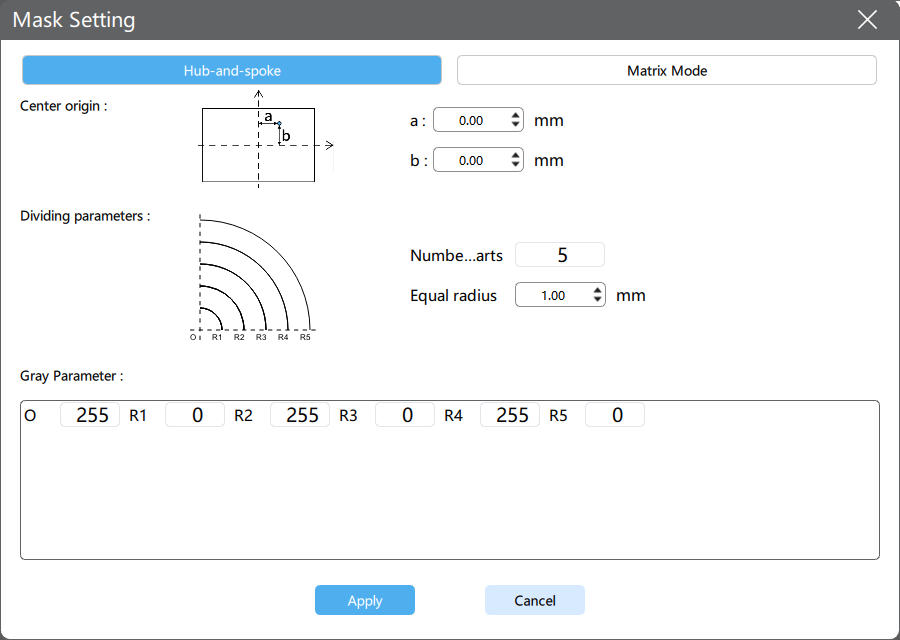
For example, if Number of equal parts is set to 5, Equal radius is set to 3mm, the radius of the ripple will be
Here is a comparison for different Equal radius:
9.1.2 Matrix Mode
Matrix Mode generates a matrix-like pattern. Rows and columns are set by m and n respectively.
The range of Gray Parameter is from 0 (black) to 255 (white).
For example, here is a 2 3 matrix with different grayscales.
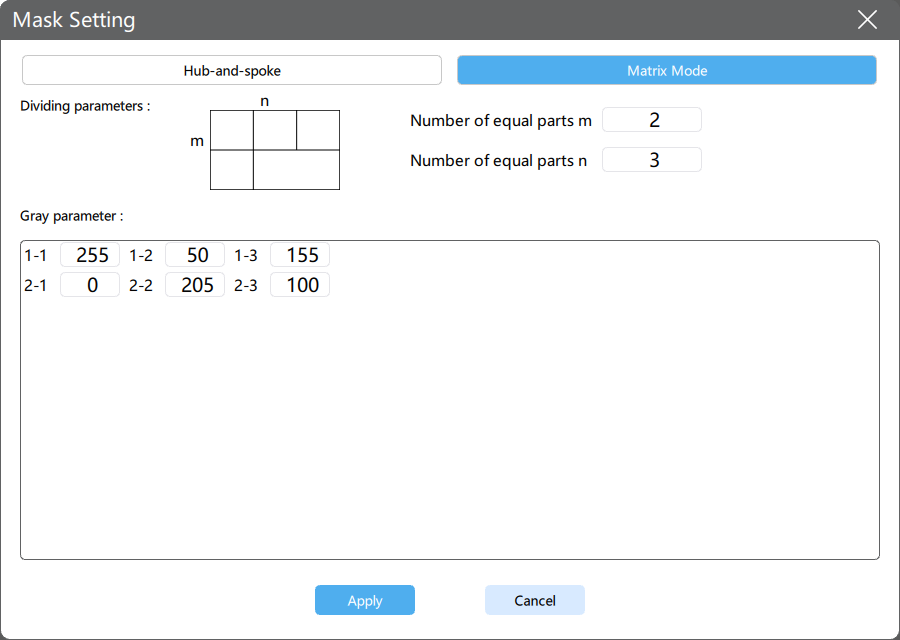
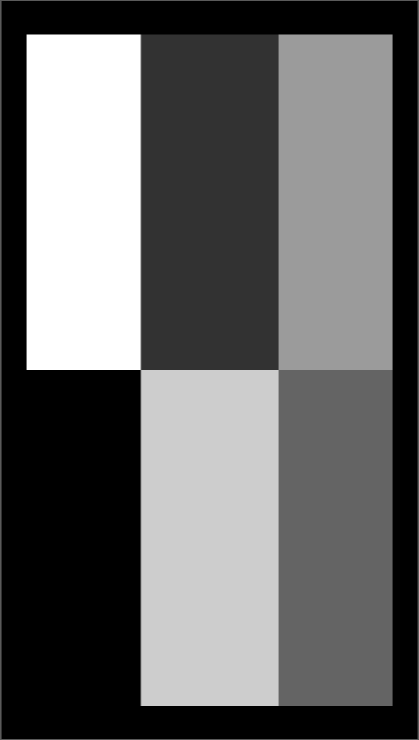
9.2 Gray scale unit
Gray scale unit is used to average the grey value of specified number of pixels in X-axis direction, and apply averaged grayscale to pixels in corresponding position of the original image.
Example:
Let's say the size of the build plate is 80mm 120mm, the resolution of the screen is 800px 1200px.
This is the mask picture, also with resolution of 800px 1200px. All squares in the picture have the size of 50px 50px.
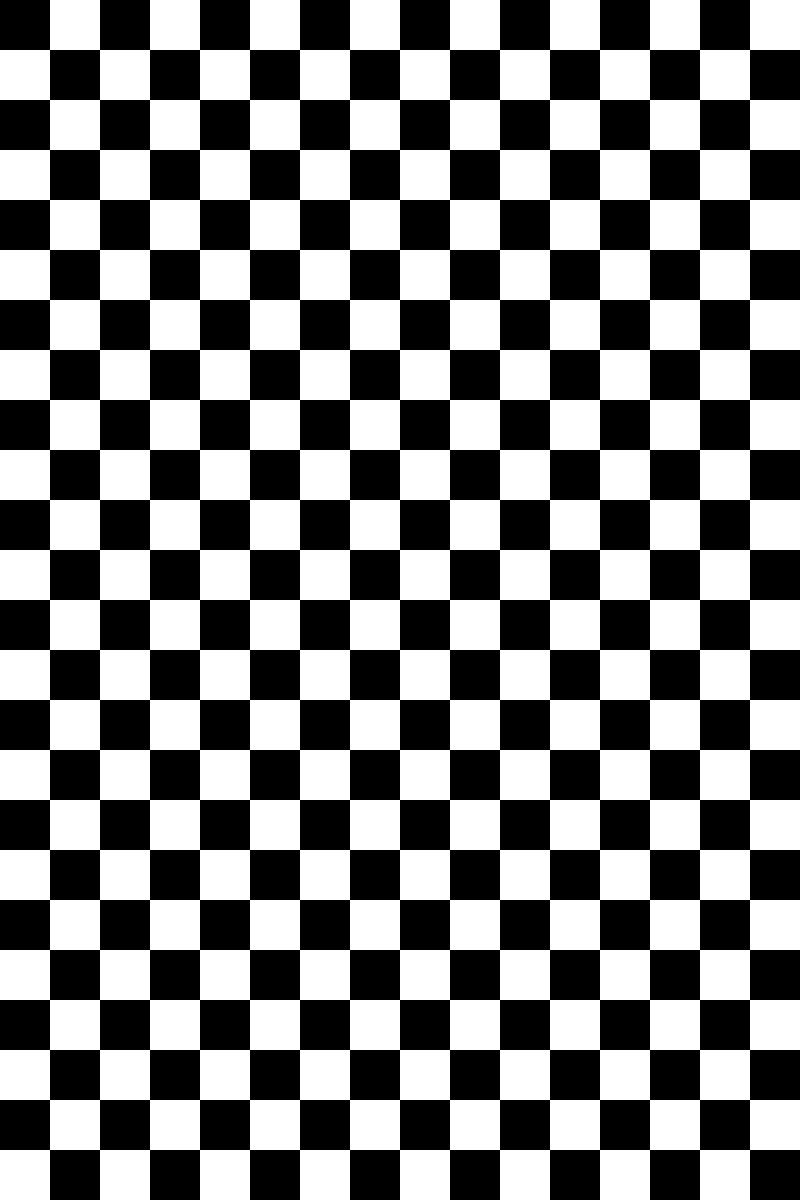
If the Gray scale unit was set to 51px, the processed image will be like this:
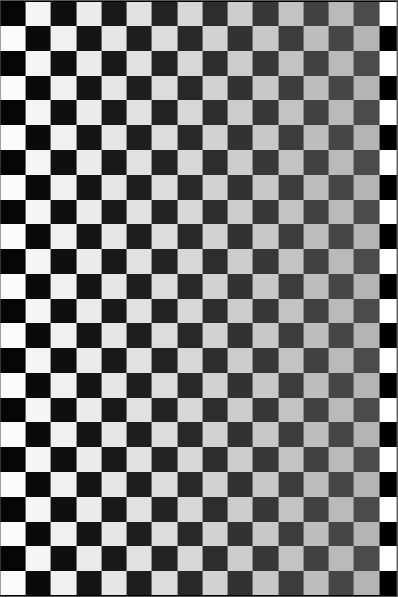
The greyscale increases from left to right as a result of averaging out every 51 pixels. Take the first row as an example: The first 51 pixels include 50 black pixels and 1 white pixel. The resulting average value is a tint lighter than pure black, barely noticeable to the naked eyes. The second group of 51 pixels contains 49 white pixels and 2 black pixels, averaging out to a color slightly darker than white. The third group of 51 pixels will be masked to the average greyscale of 48 dark pixels and 3 white pixels and so on, until we reach the remaining 35 odd pixels.
, remainder 35
This remaining pixels' grey sclae will be the average of 35 pixels of the same shade. Therefore, the resulting grayscale doesn't change.
Printer
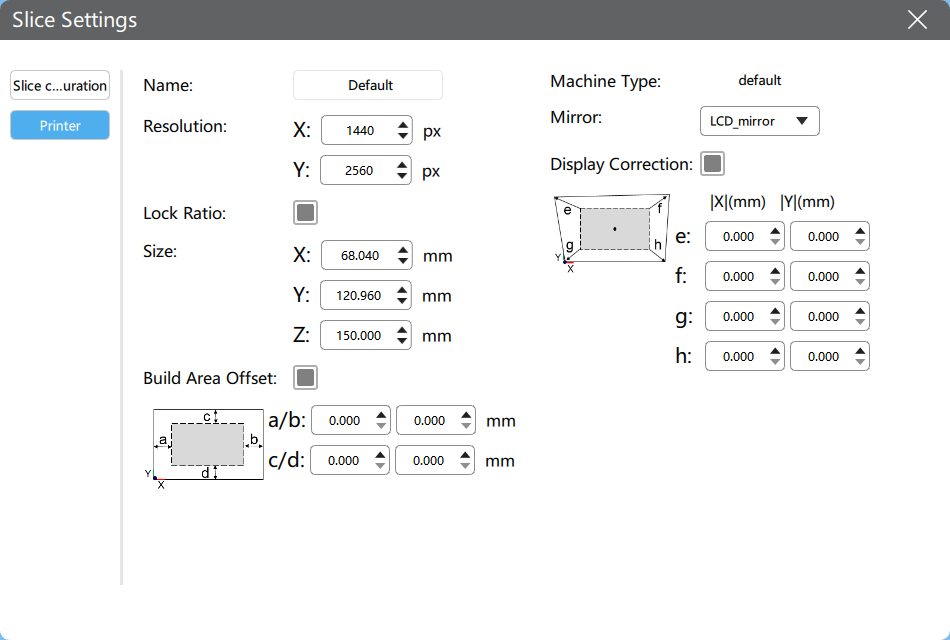
Learn more about Mirror 📃here.
Build Area Offset is designed for the case when there are bad points in the edge area of your printer's curing screen, or when parts of the edge are non-working areas. Build Area Offset is used to avoid those areas.

